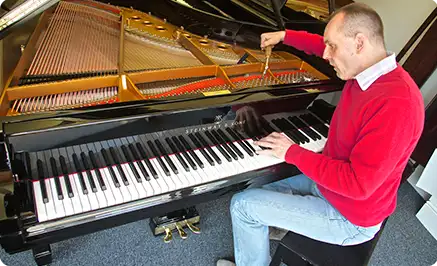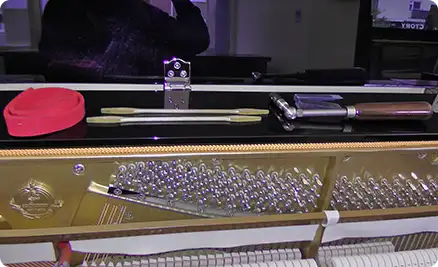Piano Tuning
The entire piano is under continual stress to a varying degree and it is the fluctuations in these stresses that cause the piano to go out of tune.
- NATIONWIDE TUNING SERVICE AVAILABLE
Why does my piano go out of tune?
There are a multitude of factors which affect the tuning and the stability of a piano. The entire piano is under continual stress to a varying degree and it is the fluctuations in these stresses that cause the piano to go out of tune.
Considering the 230+ steel strings that are tensioned to between 150 – 200lbs each means the cumulative total on the iron frame, and the solid wooden ‘back’, are subject to stresses of between 18 – 20 tons. When these strings slacken naturally their tension reduces and the piano then becomes out of tune.

Useful tips at a glance
- Have your piano tuned at least TWICE a year
- Keep it at A440 (Concert Pitch) if possible
- Keep the room temperature stable (70°F ±5°F) is ideal
- Keep the room humidity stable (50% ±5%) is ideal

How often should my piano be tuned?
It is impossible to give a definitive answer to this question because there are so many factors that can affect the tuning stability. In a domestic environment where the temperature and humidity are relatively constant throughout the seasons a guide is at least TWICE per annum ; 2 – 3 weeks after the heating goes on in the winter, and 2 – 3 weeks after it has been turned off in the summer. This delay gives the piano an opportunity to acclimatise to the new conditions and settle prior to the strings being bought back up to pitch
To explain fully what tuning a piano actually involves is the subject of many good volumes, and too large a topic to cover in full here. It is a highly technical skill and it is not something that can be learnt in five minutes; it takes many years of study and experience to achieve this status, and is generally recognised as something you should endeavour not to do yourself !
Why do the strings slacken?
In older pianos, the primary cause of strings slackening is the tuning pins which are embedded in the wrest plank (or pinblock) become loose either due to general wear and tear over the years, or (more commonly) because the wrest plank has developed splits across or around the pin holes due to the wood drying out. Another primary cause is the movement in the soundboard. This board is made of spruce and is responsible for the resonance of the piano. Spruce is used because of its elastic nature ; the more elastic the soundboard the more pleasant the tone. The steel strings bear down on this soundboard through ‘bridges’ which in turn allows their vibrations to be amplified.
Atmospheric changes – Due to the very nature of the whole construction, pianos are very sensitive to atmospheric changes in temperature and barometric pressure. During the warmer months the atmosphere is quite humid and ‘water laden’ and the wood absorbs this and swells. The strings therefore tighten which causes the pitch to raise and the piano is then out of tune.During the winter if heating is used, the moisture evapourates from the wood which therefore shrinks and the strings slacken and the pitch drops, again resulting in the piano being out of tune. If these variations become too severe it can ultimately lead to the soundboard cracking which becomes a very expensive repair option. Controlling temperature and humidity therefore plays an important part in preserving your piano
Moving a piano – Contrary to popular belief does not usually make a piano go out of tune. Again it comes down to environment and atmospheric conditions. If a piano is moved from one room to another within a uniformly heated house, then it is unlikely to go out of tune (even if it is being moved up or down stairs). If the piano however is being moved to a different location which has dissimilar conditions then it will almost certainly need tuning a couple of weeks after it has been moved.
Continuous and heavy playing – Will also make a piano go out of tune quickly since the strings are being continually vibrated and will therefore slacken off over a period of time. If a pianist is playing that continually however, it is likely that they will be having their piano tuned 4 – 6 times per year. In commercial environments pianos can often need tuning on a weekly or monthly basis depending on useage and (again) environmental fluctuations.
Age of your Piano – Has great influence on the tuning stability. We have mentioned that very old pianos may well go out of tune quite quickly due to the condition of the tuning pins and the pinblock. Young pianos (less than 5 years old) can also suffer from tuning instability due to the strings stretching and needing to ‘bed’ in. Once it has however stabilised, and provided the general principles of environment are adhered to, the piano should hold it’s pitch extremely well.
Small upright pianos – Which do not have particularly good supporting (i.e. bracings) at the back of the piano will often not hold their pitch particularly well. This is a limitation of ‘budget’ made instruments where cost of manufacture plays an important part
How much does piano tuning cost?
The following table shows our pricing structure for piano tuning and servicing.
| SERVICE TYPE | TIME | ADDITIONAL | COST |
|---|---|---|---|
| Standard Tuning | 40 - 60 mins | £100 | |
| Pitch Raise | 90 - 120 mins | TWO tunings reqd | £190 |
| Regulating | 1/2 day | Inspection needed | £400 |
| Full Service | Full day | Inspection needed | £800 |
Cancellation with Less than 48hrs notice – Full fee charged
These prices relate to normal hours of business, being Monday – Friday 9:30am – 4:00pm. Tunings are available out of hours, and at weekends, but do bear additional costs.
